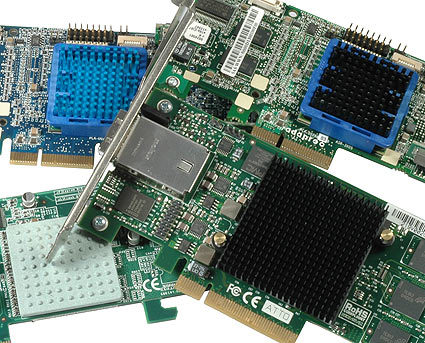Unified Serial RAID Controllers for PCIe
Unified Serial Controllers Do SAS And SATA
Professional and semi-professional RAID controllers have changed considerably since the serialization of SCSI commenced. The parallel SCSI standards shared their total bandwidth of up to 320 MB/s across all devices and required daisy-chaining devices using costly and sensitive cables. In contrast, Serial Attached SCSI (SAS) supports a dedicated 300 MB/s bandwidth per port, multi-lane or individual device cables, optional redundant cabling, and internal or external device operation. Controllers are even compatible with SATA, meaning that you can mix high-capacity SATA and high performance SAS hard drives. Finally, the transition from PCI-X to PCI Express is underway. All of these reasons were enough for us to have a look at four RAID controllers for entry level servers Compare Prices on RAID Controllers.
Many people might wonder if it even makes sense to purchase a dedicated RAID controller, considering the availability of powerful integrated SATA controllers such as Intel’s ICH9R, which can be found on many upper class motherboards such as the Asus P5K-WS (P35 chipset plus PCI-X interface) or the P5K64-WS (quad PCI Express slots). Since manufacturers have been providing their top models with high-grade voltage regulators and premium components, the quality difference between a high-end desktop motherboard and a low-end server product only lies in the feature set. With six SATA/300 ports on such a motherboard, advanced RAID management software and a dual core or quad core processor to take on the workload of RAID 5 parity calculation, why still bother with a dedicated and expensive RAID controller?
Such an integrated solution will probably do for a small workgroup server to host project and user data as well as applications, but will quickly hit its limits. Once you need more sophisticated RAID levels such as RAID 50 or 60, the integrated solutions won’t be any good. If you suddenly need to attach more than six drives, you’ll be forced to switch to a different controller. Also, if you want to run your storage array in a dedicated external appliance, or if you want to manage your drives properly, then SAS, outdated SCSI solutions or proprietary solutions are your only options.
We clearly recommend against proprietary solutions that force you to get controller plus storage appliance in a bundle for the sake of management features. The article Going the SAS Storage Way provides plenty of information on Serial Attached SCSI: interface details, cables, expanders, backplanes, hard drives, host adapters, appliances and enclosures. Using the latest SAS hard drives will give you much more storage performance than SATA ever could, but cross compatibility with SATA and flexibility of use are the key reasons to go for a unified serial controller for your small business.
Join our discussion on this topic
Get Tom's Hardware's best news and in-depth reviews, straight to your inbox.
Current page: Unified Serial Controllers Do SAS And SATA
Next Page SAS Vs. SATA
Patrick Schmid was the editor-in-chief for Tom's Hardware from 2005 to 2006. He wrote numerous articles on a wide range of hardware topics, including storage, CPUs, and system builds.
